List of Authors
>>About this blog
Recent blog post
|
[CAM]
September 4, 2017 18:00
I have contributed my posts on my blog to a journal of a meeting that I took care of during my student days.
Let me introduce it to this blog again.
1. Former Nihonbashi Ward and Osaka
(1) Meeting between the former Nihonbashi Ward and me
Since I entered university and came to Tokyo, I have lived in the western region, so I was little familiar with the Nihonbashi area. Even after living in Chuo-ku, Tokyo (although it is a remote area), I rarely went out from the Ginza and Kyobashi side to the area across the Nihonbashi River. However, on New Year's Day a few years ago, I happened to participate in an event called "Nihonbashi Seven Lucky Gods Tour" hosted by Mitsukoshi Department Store, and walked around the city of the former Nihonbashi Ward, and felt strange oldness. The streets reminded me of the area where I spent my childhood.
Junichirou Tanizaki, who was born and raised in Nihonbashi and wrote, "Hometown is a rural samurai and there is no shadow of the old Edo period."
"When I walk along the streets of the city of Kansai, I think of my childhood and feel shy. ・... When I go to Tanicho, Takatsu, and Shimoderacho in Osaka, I think, "Oh, Tokyo was like this in the past," and I feel like I found my hometown that I forgot. " (The first appearance of "Osaka and Osaka people I saw" in 1932)
People who grew up in the center of Osaka feel uncomfortable about the city of Shibuya, Hongo, etc. is that there are many slopes and the streets are not griddle (Semba, Shimanouchi, etc. in the center of Osaka City, etc. The parcel remains as Hideyoshi created, and the parcel is almost a grid.) In Osaka city, there are no slopes in the center of the city except for the slope to the Kamimachi plateau (as it is natural because it was created by alluvial sediment flowing out of the Yodo River). And there is no slope in Chuo-ku, Tokyo (although it is natural that most were created by landfill).
By the way, the elementary school and junior high school I attended (Chuo-ku, Osaka) were located east and west to Daimaru Department Stores facing Midosuji and Shinsaibashisuji. Therefore, for me, "Daimaru" is a representative of department stores, and the opening of the Tokyo store at Yaesu Exit of Tokyo Station (1954) was the "first (first) advance" to Tokyo after the war.
However, Shigure Hasegawa, who was born and raised in Nihonbashi, said, "There is a noun called Daimaru at the starting point of the most popular city. This was just the point of Nihonbashi culture and prosperity at that time, just as pointing to the Mitsukoshi kimono store right now, but at Yotsutsuji Temple on the corner opposite Toyu-cho, across Daimon-dori, It was a famous kimono store made of Odozo that had risen resolutely. " I read the description (the first edition of "Old Mon Nihonbashi, 1935), and learned that the Tokyo store was once a representative of Nihonbashi.
The Sydensteiner said:
"(Road) The influence of trains was even greater. It is a typical example of this, such as Daimaru of a kimono shop. Among the current department stores, it is not uncommon to have developed from a former kimono shop, but Daimaru was one of them, opening in Nihonbashi in the 18th century, and in the middle of the Meiji era it was more prosperous than Mitsukoshi. As Shigure Hasegawa wrote, Daimaru said, "It was the center point of Nihonbashi culture and prosperity at that time, just as it refers to the Mitsukoshi kimono store." However, unlike other stores, Daimaru did not face the train street leading from Ginza to Ueno. Therefore, customers gradually moved away, and at the end of the Meiji era, they had to knock down a store in Tokyo and withdraw to Kansai. I returned to Tokyo after World War II, but this time I set up a store in the station building of Tokyo Station to prevent it from being out of transportation." (Original book, LOW CITY, HIGH CITY, 1983)
(2) Tokyo Nihonbashi and Osaka
Knowing this led me to stroll around Chuo-ku (Nihonbashi, Ginza, Tsukiji, Akashicho, etc.) while considering its history. As a result, I once again learned that the former Kyobashi Ward was once a "water city" where Sanjumabori and Tsukiji River flow (like the center of Osaka City when I grew up). I feel that the atmosphere around the Tsukiji River in Ginza and Tsukiji River in the 1930s depicted in the movie directed by Yoshio Naruse is similar to that of the center of Osaka City at the same time (I think Osaka's economic power at that time was not comparable to Tokyo). For those from the Kansai private railway kingdom, the Inokashira Line at that time seemed to be only a rural train, and for Osaka people who were familiar with the Midosuji Subway Line, the Tokyo Metro at that time, such as the Ginza Line and Marunouchi Line, was quite poor.)
The reclaimed Sanumabori for the purpose of treating the surplus soil after the war, and the border around the former Kibori town disappeared from Ginza Nishi and Ginza Higashi (in the east side of Ginza) The area called "Ginza" has been widely expanded, and the area called "Ginza" has changed considerably to Ginza 1-8 chome, including the east side of the Osaka Nagahorisai River, and the area where the name of Senba Shinshinbashi is located in the area is now disappearsuji and west.
In this way, according to examining the history of the current Chuo-ku, when Chuo-ku was established (1947), the fact that the former Nihonbashi-ku, which boasts history and tradition, resisted the integration with the newly-established Kyobashi-ku until the end (the fact that Nihonbashi was crowned in the head of the former Nihonbashi-ku place name is due to this background). It resonates with the feelings of the Kansai people who are overwhelmed by the concentration of Tokyo, which is the "Xinxing" region in terms of economic power.
The Sydenstecker said:
"Nihonbashi may still be called the financial center of Tokyo and even Japan as a whole. The Bank of Japan and the Stock Exchange are located in Nihonbashi. But most of the big companies went out of Nihonbashi to other land. Mitsui Banking Corporation and Daiichi National Banking Corporation...The main store is no longer in Nihonbashi." ("Tokyo Shitamachi Yamanote").
"There is a record of investigating the prime location of Tokyo in 1929, but the names listed in this survey are Ginza, Shinjuku, Ueno, Asakusa, Shibuya, Ningyocho and Kagurazaka, but now there is no one who lists Ningyocho or Kagurazaka as representative prime places in Tokyo. ・・・・・・・
Ningyo-cho was very lively during the Meiji era, but has continued to decline after the earthquake. Most of the old Nihonbashi Ward was once the center of Edo townspeople's culture that both themselves and others recognized, but they all followed the same fate. Even in Ningyocho, it is a great place to explore the features of the old downtown, but in terms of gathering people, it is not comparable to that of Shinjuku. " (Original book, “Rising Tokyo,” 1990)
Mr. Yata said, "It was in the early 1950s that the transfer of the headquarters functions of large companies began from Nihonbashi. It was in the latter half of the 1950s that the distribution mechanism was shouted, and various wholesalers that had been concentrated in Nihonbashi began to feel behind. ・Since 1998, financial institutions such as regional banks have disappeared from the vicinity of the Bank due to the collapse of the bubble economy and the flow of financial restructuring. ・・ ・ ・ ・ ・ ・ ・ ・ ・ ・ ・ ・ ・ ・ ・ ・ ・ ・ ・ ・ ・ ・ ・ ・ ・ ・ ・ ・ ・ ・ ・ ・ ・ ・ ・ ・ ・ ・ ・ ・ ・ ・ ・ ・ ・ ・ ・ ・ ・ ・ ・ ・ ・ ・ ・ ・ ・ ・ ・ ・ ・ ・ ・ ・ If the part of "Nihonbashi", such as the description of Mayor Yada, is replaced with "Osaka City (Chuo-ku)", it may be accepted as it is.
It is the Nihonbashi area of Tokyo, but I am pleased that redevelopment plans have been made one after another recently, and the movement to revitalize has been remarkable. We also hear that volunteers from long-established stores in Nihonbashi, Tokyo, are collaborating with Mayfair, one of London's leading commercial areas, to develop sales channels and attract tourists. It seems that the momentum for redevelopment near the financial district Kabuto-cho has also increased. Chuo-ku plans to formulate a new plan to attract financial-related companies, including foreign-affiliated companies. The biggest symbolic project is the undergrounding of expressways that destroy the landscape across Nihonbashi, but I want them to be realized somehow.
On the other hand, it is sad and lonely that the land subsidence of the Osaka economy seems to be accelerating, rather than at all. Even if the World Exposition is realized again, will this be linked to medium- to long-term revitalization?
(Continued)
[CAM]
August 29, 2017 18:00
In the August 21 issue of the "News of the Ward", we saw the announcement of the "10th Chuo-ku Tourism Certification". Kosei took the 7th exam for the first time, the 8th exam, and is currently a tourism correspondent. However, you probably won't receive the 10th session. In recent years, I feel that "old and death" is finally sneaking behind it, and I think it is time to finally implement the planned return to Kansai. I have a deep attachment to the ease of living and convenience of Chuo-ku, Tokyo, and I have a little hesitant to leave ...
By the way, I love Osaka and Nara, and I have the second grade of Osaka certification and Nara certification. Even higher-level exams have been abandoned due to reasons such as too expensive, but after a long absence, I saw the "Osaka Test" site. Since this year is the ninth, it seems that it was started one year after the Chuo-ku Tourism Certification. Then, the guidelines were revised, and the following system was established.
"Those who have passed the first grade multiple times will be awarded and awarded the following titles.
Passed 5 advanced times ⇒ "Osaka superhumans"
Successed 3 times ⇒ "Osaka master"
Sprinkle numbering (from No. 1) in the order of arrival. If more than one person arrives at the same time, priority will be given to the person with the highest score obtained in the first grade pass test. If the total score is the same, the senior will be given priority.
○Those who have taken the exam multiple times and meet certain criteria will be awarded the following collation.
A cumulative total of 1,000 points regardless of the examination class ⇒ "Ironjin in Osaka"
Numbering (No. 1 to) is shaken in the order in which a total of 1,000 points are reached.
If you arrive at the same time, priority will be given to the higher scores obtained in past exams (whether passed or failed). If the total score is also equal, the elder will be given priority."
I thought it was an interesting attempt, and in order to encourage students to take the exam multiple times, I introduced how to consider such a system at the Chuo-ku Tourism Test.
[CAM]
August 15, 2017 09:00
I wanted to read a little about someone writing about the street 3-chome bus stop name. I am a resident of Tsukuda, so when I go to Tokyo Station, go through Chuo-ohashi Bridge and in front of Sumitomo Tin Building. → Shinkawa → Kameshima Bridge → 2, Hacchobori → I'll take a route bus called 3-chome street. When we go to Nihonbashi, we decide to get off at "Dori 3-chome" and walk a little along Chuo-dori. Therefore, this bus stop name "Dori 3-chome" is quite familiar.
The old town name "Tori" is the current Nihonbashi 1-3-chome used from the Edo period to 1972. It was named "dori" because it was a town facing the main street, and it flourished as a downtown area representing Edo with large shops lined up on the main street along the highway. (Page 173, Monoshiri Encyclopedia)
In the median strip of Yaesu Street near this stop, there is the "Jan Jooss Ten Monument". It was established in 1989 to commemorate the 380th anniversary of Japan-Netherlands service. (Page 21 of Monoshiri Encyclopedia)

Follow Chuo-dori, once the downtown area of Edo, and you will find the Takashimaya Nihonbashi store on the right and Maruzen bookstore on the left. The Takashimaya Nihonbashi store was completed in 1933 and was designated as an Important Cultural Property for the first time as a department store building in 2009. (Pages 21 and 129 of the Monoshiri Encyclopedia)
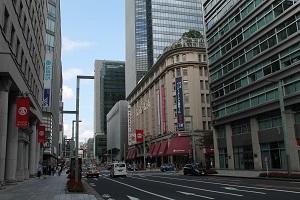
On the left side of Nihonbashi, the Nihonbashi Tourist Information Center was recently established.

In front of the Mitsukoshi Nihonbashi Main Store, there is the Nara Mahoroba-kan. I often visit.
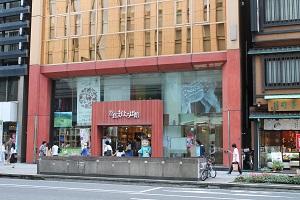
When I visited Nihonbashi, on my way home, I walked along Eitai-dori St. to Eitai Bridge.
There is a monument of "Meisui Shirakiya Well" at Choledo Nihonbashi Annex Square on Eitai-dori St. (Pages 21 and 134 of the Monoshiri Encyclopedia)
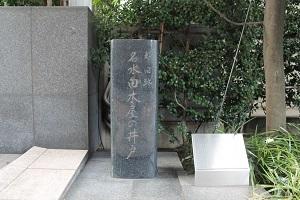
On the right side is a monument about "The stage of Soseki masterpieces".
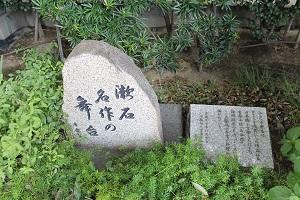
In addition, when you walk along Eitai-dori St., there is also a monument to "The Ruins of the Corner Residence". (Page 23 of Monoshiri Encyclopedia)
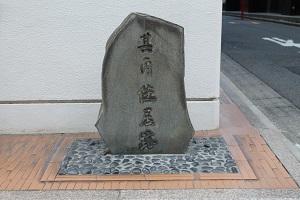
If you go further, you will pass through the Reigishi Bridge. It is a bridge that functions as a river. When viewed from Hashigami, you can see "Shin Kameshima Bridge" and "Kameshima Bridge" first.
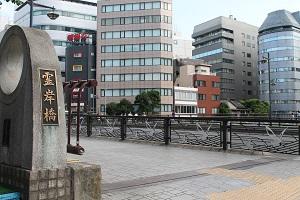

Normally, I like to return on the river terrace of the Sumida River from the side of Eitai Bridge while being blown by the river breeze, but today (July 13), I decided to return to Yaesu Street and Kamejima Bridge here .
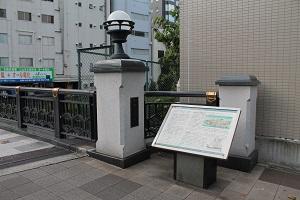
This area is called "Shinkawa" in the current place name, but until 1971 it was called "Echizenbori". ("Monoshiri Encyclopedia" page 174) The old place name remains in the store name etc.
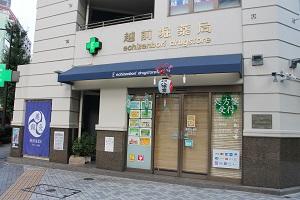
Today (July 13) is Reitaisai festival in Tomioka Hachiman. The photo shows the square in front of the Sumitomo Twin Building.
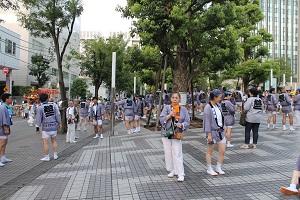
When you come to this point, Chuo-ohashi Bridge is already in front of you. Cross the St. Luke's Tower on the right, Tokyo Sky Tree, Eitai Bridge, etc. on the left, and you will enter Tsukuda.
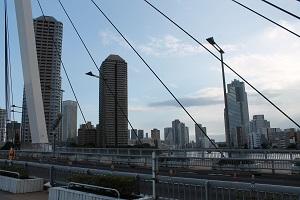
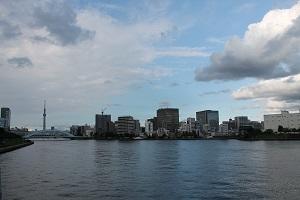
[CAM]
July 28, 2017 14:00
Today (July 27), I worked as a guide for "Tsukiji Outer Market Part 1" of the "Waku Waku Tour" hosted by the Tourism Association.
First, the meeting was in front of the convenience store Lawson at the intersection of Harumi-dori St. and Shin-ohashi-dori St. Participants are 10 people, 4 people in the ward and 6 people outside the ward. It means that there were 42 applicants, so they were selected by 4.2 times lottery.

Today's main destinations are "Egg Yaki Daisada", "Nori Hataya Shoten", "Salmon Showa Food", and "Konbu Suita Shoten" located in Tsukiji Outer Market.
"Daisada of egg-yaki" has a branch in the out-of-office market (Tsukiji 4-13-11), as well as in-house market and fish-gashi Yokocho. It has a wide customer base, including high-end sushi restaurants, high-end restaurants, department stores, and high-end supermarkets all over the country. It is carefully hand-baked using carefully selected ground eggs with safe and secure, and has a history of 90 years since the first generation as a manufacturer of egg-yaki.
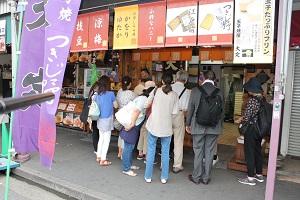
"Hatoya Nori Store" (Tsukiji 4-14-16) is a dry laver wholesaler in Tsukiji founded in 1930. We handle dried foods such as seaweed and have a wide selection of seaweed from all over Japan, such as Ariake products, and propose seaweed that is suitable not only for grilled seaweed but also for various scenes. In addition, we have a wide selection of dried foods such as nuts and dried fruits as well as seaweed. It is also popular as a souvenir shop where you can feel the vibrant voice of the third generation representative and the style of downtown that still remains in the cityscape outside Tsukiji.
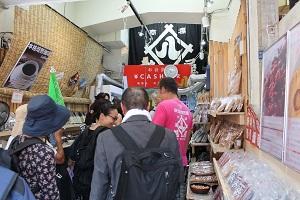
"Showa Food of Salmon" (Tsukiji 4-13-14) selects and ships the highest quality salmon from salmon found throughout Japan. Focusing on natural salmon, red salmon, and autumn salmon, there are also items that are difficult to obtain elsewhere, such as "Southern nose bend", which is nostalgic under the name of "salt pulling", and "Super dry red salmon", which is so spicy that salt erupts. I am.
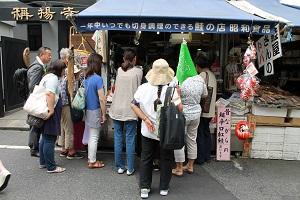
"Suita Shoten" (4-11-1 Tsukiji) is a long-established kelp that has been operating for more than 120 years. We are proud of a wide selection of products in preparation for professional Japanese food. 95% of kelp is from Hokkaido. However, even in the same Hokkaido product, the taste, texture and dashi differ depending on the production area. It should be used according to the purpose. However, it is not easy to know whether it is a good kelp just by appearance. There is a theory that "white flour is blowing has a lot of umami", but this is not always said. In addition, it can not be said that "natural is better than aquaculture." At specialty stores, we propose the perfect one according to the purpose and budget, so please consult a professional and choose it.
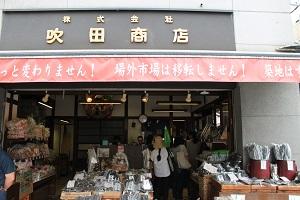
After going around the four shops, pass in front of the Tsukiji Fish Bank and go to Haji Shrine. After that, from Kachidokibashi, today's tour was completed, looking at the newly built Tsukiji Ohashi and Tsukuda / Tsukishima towers and condominiums.
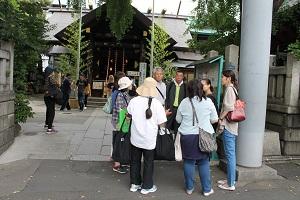
[CAM]
July 13, 2017 18:00
We introduced photos of "Tsukishima Kusaichi", but they are preparing for Saturday. When I visited again after the event, there were quite a lot of people.
Once again, I would like to introduce a few scenes that are crowded with parents and children.
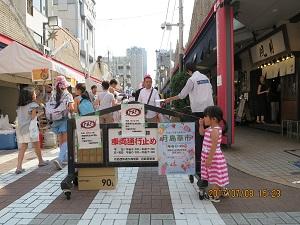
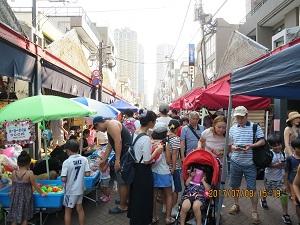
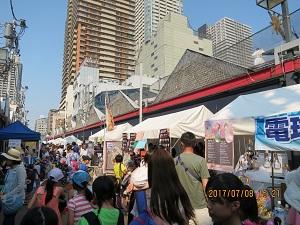
The white enclosure behind is the planned redevelopment building site. The project will be completed at the end of March 2021, so after the Olympic Games.
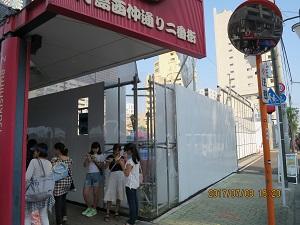
[CAM]
July 10, 2017 09:00
Saturday, July 8 9 (Sun) is "Tsukishima Kusaichi".
As stated in the Monoshiri Encyclopedia, "When the tray approaches, there was a city that sold tray supplies such as Houroku, Ogara, and Hozuki. This is the beginning of Kusaichi, which is now held on the weekend of early July, and there are various stalls on the 500m Tsukishima Nakadori shopping street."
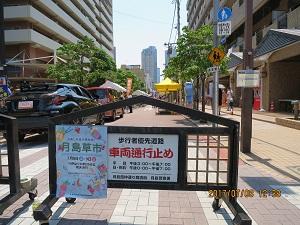
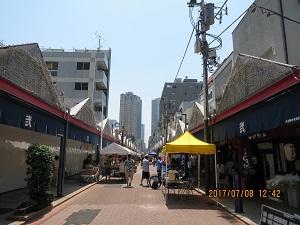
Everyone at Tsukuda Junior High School preparing for the opening event and drum performance.
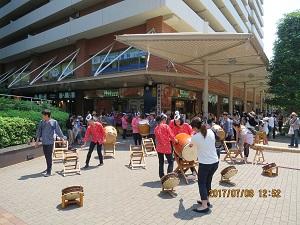
In Tsukishima Nakadori Shopping Street (commonly known as Monja-dori), large-scale apartments have been started through the urban redevelopment project. It's a 32-story building, so it's lonely that the downtown atmosphere disappears, but when it's completed, the image of the street will change again. It is scheduled to be completed on March 31, 2021, but the site area is quite large and it is likely to be a considerable large condominium, and this will increase the population of Chuo-ku again.
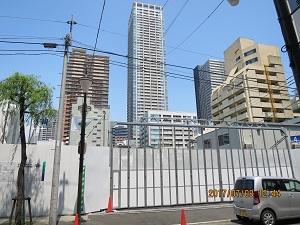
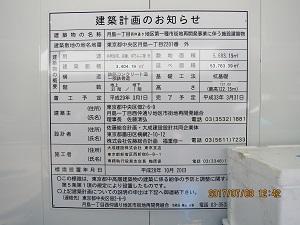
In the vicinity, there is the site of the Tsukishima Machinery Headquarters as a large remaining land. Currently, it is a parking lot, but if a high-rise apartment is built here, the Tsukuda and Tsukishima areas will be further converted into high-rise apartments.
In Tsukuda, the closed site of public bath has been transformed into a medium-sized condominium. In addition, the site of a small store is gradually turning into small and medium-sized condominiums. Two subways, the Metro Yurakucho Line and the Toei Oedo Line, are available, and the Tsukuda and Tsukishima districts, which are within walking distance to Yurakucho and Ginza, are likely to increase the population.
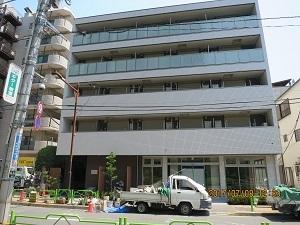
|
Links
|

